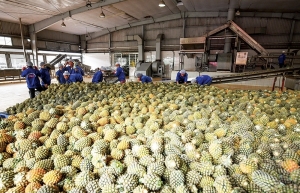Ingredients groups seize market share
According to statistics released by the General Statistics Office (GSO) at the end of September, Vietnam’s food sector has a robust growth rate of over 10 per cent annually, delivering more competitive goods, dominating the home market, and expanding exports.
 |
| Modern production line with European processing technologies for food ingredients at AFI - a subsidiary of AIG |
Vietnam’s food production and processing sector accounts for 19.1 per cent of the value of its processing and manufacturing industries. This is the industry that accounts for the largest part of the processing and manufacturing sectors, satisfying both domestic and international food demands.
Alongside this expansion is the section that provides food ingredients to manufacturing companies, including instant noodles, milk, juices, quick meals, candies, and beer. According to the Vietnam Trade Promotion Agency of the Ministry of Industry and Trade, the food ingredient sector has enormous development potential.
According to a forecast published in August by Mordor Intelligence, Vietnam’s food and beverage business could increase by up to 8.65 per cent annually. This is a good prognosis for the growth of the food business between 2021 and 2026, even though it will continue to be impacted by the pandemic and the rising cost of inputs.
A plentiful supply of raw materials, including rice, coffee, pepper, cashews, aquatic goods, and vegetables, is also conducive to the growth of the food processing sector in Vietnam. Vietnam exports about $1 billion worth of tapioca products annually. According to the GSO, exports of tapioca starch in the first nine months of 2022 totalled 1.55 million tonnes worth $769 million, an increase of 21.1 per cent in volume and 29 per cent in value over the same period in 2021.
According to Agrotrade Vietnam of the Ministry of Agriculture and Rural Development, Vietnam may export $4 billion worth of fruits annually, of which about 70 per cent is fresh fruit (dragon fruit, passion fruit, and mango) used as juice ingredients. The density of trees In addition, coffee exports roughly $4 billion per year and cashews around $3.6 billion per year.
The potential to use local raw materials for processing is readily accessible, and it will be easier for firms to invest in growing regions themselves, assuring the proper criteria for output volume and quality.
There are two primary raw material providers in the Vietnamese market – those that directly construct raw material regions for manufacturing and delivery to processing facilities, and those that import from outside for distribution in Vietnam.
By the end of 2021, the nation boasted more than 8,500 industrial-scale agricultural product processing firms with an annual capacity of around 120 million tonnes of raw materials.
Domestic and foreign businesses have poured capital into food processing plants, utilising the space to rapidly increase sales and profits, such as Asia Ingredients Group (AIG), Asia Saigon Food Ingredients (AFI), and Asia Hoa Son Corporation.
AIG is the company with the highest share of the domestic food ingredient industry, and has constructed two big raw material sites in Vietnam (see interview). Founded as a trading firm with 100 per cent Vietnamese capital, it grown its production and spent extensively on research and development to become the dominant company in Vietnam’s raw materials industry.
Elsewhere, AFI is an expert manufacturer of non-dairy creamer powder, fat-filled milk, cereal flakes, stabiliser, and powders. The AFI plant is situated in My Phuoc 3 Industrial Park of Binh Duong province, and is outfitted with a contemporary equipment system based on the spray drying technology of Denmark and Germany, and employs a team of highly skilled specialists.
According to the Ministry of Industry and Trade, the consumption of processed foods and drinks has climbed by 9.68 per cent annually on average over the last five years. From the standpoint of foreign-invested businesses, Vietnam’s food processing sector is appealing due to its abundance of agricultural and food production raw resources.
However, the agriculture business, with an export capability of $50-55 billion per year, continues mostly to export low-added-value raw commodities.
 | Processing prevents EU agro-increase While the sharp increase in food prices across Europe has opened up prospects for Vietnamese agricultural exporters, processing issues remain at the forefront. |
 | Processing - manufacturing, real estate top FDI attraction in nine months Processing - manufacturing and real estate are the biggest magnets for foreign direct investment (FDI) in the first nine months of 2022, statistics showed. |
 | ProPak Vietnam 2022-a dedicated business platform in the processing and packaging technology industry ProPak Vietnam 2022, a leading international trade event on the processing and packaging technology industry for Vietnam's food, beverage and pharmaceutical industry, will take place from November 9 to 11 at the Saigon Exhibition and Convention Centre (SECC) in District 7, Ho Chi Minh City. |
What the stars mean:
★ Poor ★ ★ Promising ★★★ Good ★★★★ Very good ★★★★★ Exceptional
Related Contents
Latest News
More News
- Businesses ramp up production as year-end orders surge (December 30, 2025 | 10:05)
- Vietjet chairwoman awarded Labour Hero title (December 29, 2025 | 13:06)
- How to unlock ESG value through green innovation (December 29, 2025 | 10:03)
- AI reshapes media and advertising industry (December 29, 2025 | 08:33)
- FPT and GELEX sign deal to develop blockchain tech for global markets (December 29, 2025 | 08:29)
- Vietnam’s GDP forecast to grow by 9 per cent in 2026 (December 29, 2025 | 08:29)
- Women entrepreneurs are key to Vietnam’s economic growth (December 29, 2025 | 08:00)
- Vietnam's top 500 value-creating enterprises announced (December 27, 2025 | 08:00)
- The PAN Group shaping a better future with ESG strategy (December 26, 2025 | 09:00)
- Masan Consumer officially lists on HSX, marking the next phase of value creation (December 25, 2025 | 13:20)

 Tag:
Tag:





















 Mobile Version
Mobile Version